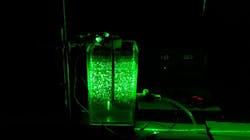Research finds new flocculation monitoring technique
Researchers have developed a new technique to monitor flocculation and mixing, according to a press release from Texas A&M University by Alyson Chapman.
Water is a vital resource, and clean water is a necessity. Texas A&M University researchers have developed a new technique to monitor one of the key processes of purifying water in real time.
Raw water contains microscopic pathogens that are too small to remove during water and wastewater treatment easily. Chemicals are added to form large clumps called flocs, which are easily filtered out. Flocculation, a key process in water treatment, removes suspended particles from the water.
"Coagulant chemicals need to be added to purify drinking water and remove turbidity (cloudiness) and microbes that are too small to be visible to the naked eye," said Kuang-An Chang, professor in the Zachry Department of Civil and Environmental Engineering at Texas A&M.
But it is necessary to properly mix the water and chemicals, so the pathogens properly clump. If mixing is low, clumps won't form. If mixing is too intense, clumps will form but quickly break apart.
The new method simultaneously monitors the shape of the clumps and the mixing intensity in a single step, in real time, allowing for more accurate measurements.
With mixing being one of the most energy-consuming processes during water and wastewater purification, the research could uncover major energy reductions.
The results of this study were recently published in the journal ACS ES&T Engineering and featured on the cover of its February issue.
"We developed a brand-new technique to non-intrusively monitor the mixing so that we can precisely control it, quantify heterogeneities within the reactor and potentially optimize it to create flocs of desired characteristics, while simultaneously minimizing energy consumption," said Chang.
This first-of-its-kind technique can be used to improve flocculation, successfully removing contaminants by growing large enough clumps while minimizing the energy used.
"All previous research did this in two steps," Chang said. "In the old approach, first, artificial particles of known characteristics would be added to monitor mixing. Then, a second experiment would be done with ‘identical’ settings and the actual clumps would be monitored.
"We essentially halved the workload and improved precision because there are always statistical differences any time you do two experiments."
